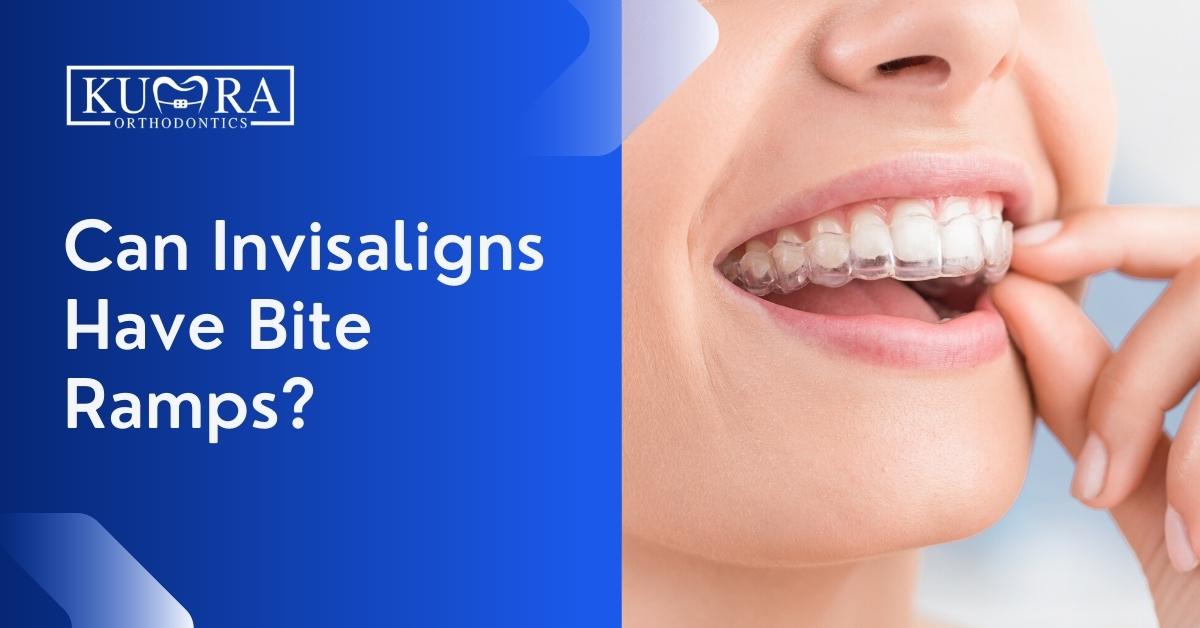A clear aligner, such as Invisalign, is a type of orthodontic appliance used to straighten misaligned teeth. Clear aligners, alternatively called invisible braces, are custom-molded mouthpieces made of medical-grade plastic that apply pressure on teeth, guiding them into the desired position. Clear aligners are a more discrete alternative to metal braces.
This article will discuss the Invisalign bite ramp and how it can assist in addressing deep bites.
What Is a Bite Ramp?
A bite ramp is a little pyramid-shaped structure attached to the transparent aligner. It is custom-positioned on the clear aligner to interact with your teeth and expedite the process of bite restoration. Bite ramps are often situated behind the front incisors.
The biting ramps aim to disocclude the posterior teeth, relieving pressure. Because we frequently need to open the bite in cases of deep bite, ensuring that no pressure is placed on the posterior teeth.
The upper teeth must be pushed up and back into their normal positions to address a deep bite. And to accomplish so, we must create space between the rear upper and lower teeth to allow the teeth and jaws to realign properly.
Depending on your treatment plan, you may wish to intrude the anterior teeth, extrude the posterior teeth, or combine the two.
Bite ramps are not included on every Invisalign clear aligner, as not everyone has a deep bite or an overbite. It depends entirely on the circumstances surrounding each patient’s situation and treatment process.
Bite ramps were introduced with the Invisalign® G5 protocol. Align Technology®, the producers of Invisalign transparent aligners, come up practically every year with a new technique. The G5 protocol was established to improve how we treat deep bite instances and improve success prediction. That protocol included a few new features, one of which was the bite ramp.
Needing an orthodontic appointment?
Visit Kumra Orthodontics Washington, DC or Kumra Orthodontics Stafford, VA, and request an appointment with us!
How Do Bite Ramps Work?
The biting ramp prevents your upper teeth from fully overlapping your lower front teeth. As a result, your back teeth remain apart, creating space between your upper and lower jaws at the rear. This allows your teeth and jaws to reposition themselves properly.
Over time, as your front teeth shift up and back, your back teeth will drift closer together. Your rear upper and lower teeth will eventually come into contact again. The biting ramps provide space for this to occur, but they also train your jaw to bite correctly, making it feel more natural after your teeth have moved to their proper positions.
What is a Deep Bite?
According to the American Association of Orthodontists (AAO), a deep bite occurs when the back teeth are closed when the upper front teeth overlap the lower front teeth excessively. Additionally, this is referred to as an overbite or closed bite. While a slight overbite is typical, a deep bite is defined as a severe overbite of more than 4mm.
While a deep bite may or may not be an aesthetic concern for most patients, its existence usually suggests that there are further issues that need to be addressed.
The top teeth must be pushed up and back into their normal positions to cure a deep bite. And to accomplish so, we must create space between the rear upper and lower teeth to allow the teeth and jaws to realign properly. This allows your teeth and jaws to move into their proper position.
Related: Can Invisalign Fix Underbite?
Why Are Deep Bites A Problem?
You might be wondering why orthodontists regard a deep bite as a concern. The main issue with a deep overbite is that it can cause damage to the teeth over time.
A deep bite is a fairly common type of bite that orthodontists frequently correct with braces. However, the approach we use to repair the deep bite will be determined by the severity of the bite problem.
On Mild Deep Bite
If a patient has a mild deep bite, they may be able to be fixed with regular Invisalign aligners alone.
On Moderate Deep Bite
We may need to utilize extra appliances, such as Invisalign bite ramps or elastics, for patients with a more moderate to severe deep bite.
Invisalign bite ramps are little triangle-shaped ramps inserted behind the front teeth on the Invisalign aligner. When the Invisalign aligners are worn, these biting ramps separate the back teeth slightly, and over time, the back teeth gradually drift together.
A deep bite can typically be corrected by adding bite ramps to the Invisalign aligners and allowing the back teeth to drift together. These bite ramps are attached to the Invisalign aligners and will typically remain in place for the duration of treatment.
Invisalign is capable of correcting around 90% of all deep bites. However, certain severe deep bites may benefit from orthodontic treatment with braces or another type of orthodontic equipment.
Consult with Kumra Orthodontics to learn more about Invisalign Bite Ramp
If you think that Invisalign may be the right treatment for you or your child, please don’t hesitate to contact Kumra Orthodontics today. We would be more than happy to provide a complimentary consultation so that we can develop a customized treatment plan for you.


